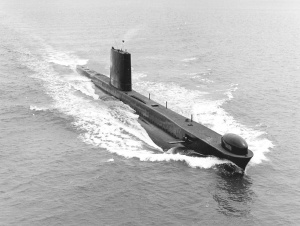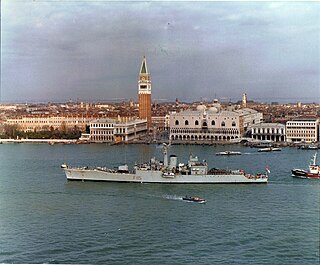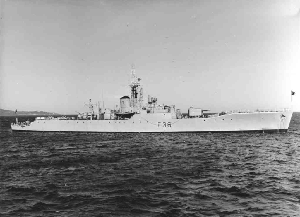
HMS Sealion (S07) was a Porpoise-class submarine.
HMS Kirkliston (M1157) was a Ton-class minesweeper of the Royal Navy, built by Harland and Wolff and launched on 18 February 1954. In a brief episode from 1956 to 1960 she was temporarily renamed HMS Kilmorey and was assigned to the Ulster division Royal Naval Reserve (RNR).

HMS Torquay was a Type 12 Whitby-class frigate of the British Royal Navy. They were the first frigates to have the "V" form hull. This evolutionary design made it possible to be driven in head sea without the usual slamming which occurs with conventional destroyers of the time. Each frigate cost 3.5 million pounds and the first ship completed was Torquay in May 1956.

HMS Rorqual (S02) was a Porpoise-class submarine launched in 1956. She was built by the Vickers shipyard in Barrow-in-Furness, Cumbria, England. The boat was named for both the rorqual, a family of whale, and the earlier Second World War-era submarine of the same name.
HMS Dittisham was one of 93 ships of the Ham-class of inshore minesweepers built for the British Royal Navy. Their names were all chosen from villages ending in -ham. The minesweeper was named after Dittisham in Devon.
HMS Puttenham(M2784) was a Ham-class inshore minesweeper of the Royal Navy. She was launched in 1956 and entered service in 1958. The 93 ships of the Ham class had names chosen from villages ending in -ham. The minesweeper was named after Puttenham.

The Acorn class was a class of twenty destroyers of the Royal Navy all built under the 1909-1910 Programme, and completed between 1910 and 1911. The Acorns served during World War I.

HMS Brighton was a Rothesay or Type 12I class anti-submarine frigate of the Royal Navy.

HMS Lowestoft was a Rothesay-class or Type 12 class anti-submarine frigate of the British Royal Navy. Lowestoft was reconstructed in the late 1960s to largely the same pattern as the third group of Leander-class frigates, with new radar and fire control and a hangar and pad for a Westland Wasp helicopter for longer range, anti-submarine, engagement. In the late 1970s it was converted as the prototype towed array frigate for the Royal Navy, but retained its full armament. Lowestoft was sunk as a target on 8 June 1986 by HMS Conqueror using a Tigerfish torpedo. She was the last Royal Naval target to be sunk still displaying her pennant number.

HMS Berwick was a Rothesay- or Type 12I-class anti-submarine frigate of the British Royal Navy. She was built by Harland & Wolff and launched on 15 December 1959.

HMS Tenby was a Whitby-class or Type 12 anti-submarine frigate of the Royal Navy of the United Kingdom.

HMS Whitby was a Whitby-class or Type 12 anti-submarine frigate of the Royal Navy of the United Kingdom built by Cammell Laird and Co Ltd, Birkenhead. She was launched on 2 July 1954 and commissioned on 10 July 1956.

HMS Narwhal (S03) was a Porpoise-class submarine of the Royal Navy. She was launched on 25 October 1957.

HMS Weymouth was a Town-class light cruiser built for the Royal Navy during the 1910s. She was the name ship of the Weymouth sub-class of the Town class. The ship survived the First World War and was sold for scrap in 1928.
HMS Shoulton (M1182) was a Ton-class minesweeper of the Royal Navy. Constructed by the Montrose Shipyard in Montrose, Scotland and launched on 10 September 1954, the minesweeper was converted into a prototype minhunter in 1957. The vessel was used as a test bed in the mid-1960s for new propulsion technologies. Shoulton was among the vessels assigned to salvage operations following the Aer Lingus Flight 712 crash off Rosslare. In 1977, Shoulton took part in the naval review marking the Silver Jubilee of Elizabeth II and was paid off on 23 November 1979. The ship was sold for scrap in 1981 and broken up at broken up in Blyth.
HMS Hodgeston was a Ton-class minesweeper which saw service with the Royal Navy during the Cold War. Built by Fleetlands Shipyard, she was launched on 6 April 1954 and broken up in 1988.
HMS Brereton (M1113) was a Ton-class minesweeper of the Royal Navy. Brereton was built by the Lowestoft shipbuilder Richard Ironworks, and was launched in 1953 and entered service in 1954.

The Douro class destroyers consisted of five ships used by the Portuguese Navy and two used by the Colombian Navy, all built during the 1930s. Note, that, in Portugal, this class of destroyers is usually referred to as the Vouga class, with the term Douro class being usually employed to designate the previous class of Portuguese destroyers also known as Guadiana class.
The Scimitar class was a class of three unarmed fast patrol boats operated by the British Royal Navy for the training purposes in the 1970s. They were built by Vosper Thornycroft in 1969 to 1971 and were withdrawn from use in 1981.
INS Brahmaputra was a Leopard-class frigate of the Indian Navy. She was built by the Scottish shipbuilder John Brown & Company and completed in March 1958. Brahmaputra served during the Indo-Pakistani War of 1965 and the Indo-Pakistani War of 1971. She was scrapped in 1986.













